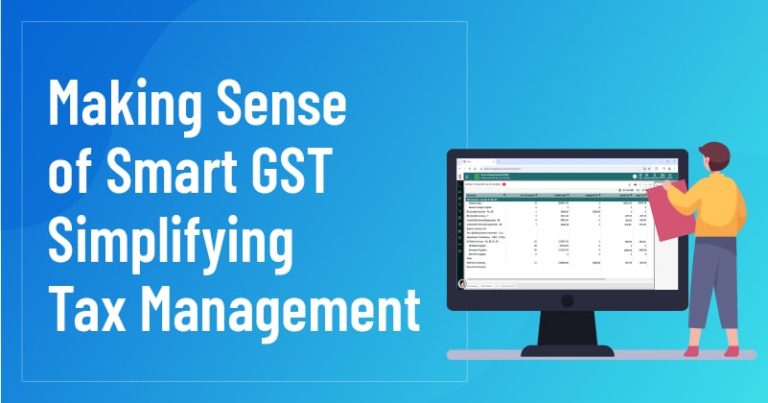In the world of business, taxes play a crucial role. They ensure that governments have the funds necessary to provide public services and infrastructure. However, tax management can be complex and time-consuming, especially for small businesses. Enter Smart GST – a revolutionary approach to tax management that aims to simplify the process for businesses while ensuring compliance with regulations. In this blog post, we’ll delve into what Smart GST is, how it works, and its benefits for businesses.
Understanding Smart GST
GST, or Goods and Services Tax, is a value-added tax levied on the supply of goods and services. It is a destination-based tax, meaning it is levied at the point of consumption rather than the point of origin. Smart GST takes this concept a step further by leveraging technology to streamline the tax management process.
How Does Smart GST Work?
At its core, Smart GST relies on automation and digitization to simplify tax compliance. It involves the use of software and online platforms to handle various aspects of GST, including registration, return filing, and payment.
One of the key components of Smart GST is the GST Network (GSTN), a technology platform that facilitates the implementation of GST. The GSTN acts as a central repository of tax-related information, allowing businesses to register, file returns, and make payments online.
Benefits of Smart GST
- Simplified Compliance: Perhaps the most significant benefit of Smart GST is that it simplifies tax compliance for businesses. By automating processes such as return filing and payment, businesses can save time and reduce the risk of errors.
- Increased Transparency: Smart GST promotes transparency in the tax system by providing real-time access to tax-related information. This helps businesses and tax authorities alike to track transactions more efficiently and identify potential discrepancies.
- Cost Savings: By streamlining tax processes and reducing the need for manual intervention, Smart GST can lead to cost savings for businesses. This is particularly beneficial for small and medium-sized enterprises (SMEs) with limited resources.
- Improved Cash Flow: With faster processing times for returns and refunds, Smart GST can help businesses improve their cash flow management. This is because businesses can receive refunds more quickly, allowing them to reinvest the funds into their operations.
- Reduced Compliance Burden: Traditionally, tax compliance has been a significant burden for businesses, requiring them to devote time and resources to ensure compliance with regulations. Smart GST helps alleviate this burden by automating many compliance-related tasks.

Challenges and Considerations
While Smart GST offers numerous benefits, its implementation is not without challenges. One of the main challenges is ensuring that businesses have access to the necessary technology and resources to adopt Smart GST effectively. Additionally, there may be concerns related to data security and privacy, particularly regarding the collection and storage of sensitive tax information.
Another consideration is the need for ongoing training and support to help businesses adapt to the new system. This includes providing guidance on how to use GSTN effectively and addressing any technical issues that may arise.
Implementation of Smart GST
Implementing Smart GST requires collaboration between businesses, government agencies, and technology providers. Here’s a closer look at how Smart GST can be implemented effectively:
1. Technology Infrastructure: The foundation of Smart GST is a robust technology infrastructure that enables seamless communication and data exchange between businesses and tax authorities. This includes the development of the GSTN platform, which serves as the backbone of the Smart GST system. Governments need to invest in the necessary IT infrastructure and ensure that businesses have access to reliable internet connectivity and digital tools.
2. Training and Education: To ensure successful adoption of Smart GST, businesses need to be adequately trained on how to use the new system. This includes providing training sessions, workshops, and educational materials to help businesses understand the various features of GSTN and how to navigate the platform effectively. Governments and industry associations can play a crucial role in providing training and support to businesses during the transition to Smart GST.
3. Integration with Existing Systems: Many businesses already use accounting software and other digital tools to manage their finances. To streamline the adoption of Smart GST, it’s essential to ensure that these existing systems can integrate seamlessly with the GSTN platform. This may require collaboration between software providers and government agencies to develop standardized APIs and data formats for data exchange.
4. Monitoring and Evaluation: Once Smart GST is implemented, it’s crucial to monitor its performance and effectiveness continually. This includes tracking key metrics such as compliance rates, processing times, and user satisfaction levels. Governments can use this data to identify areas for improvement and make adjustments to the system as needed.
Impact of Smart GST
The implementation of Smart GST is expected to have a significant impact on businesses, tax authorities, and the economy as a whole. Some of the key impacts include:
1. Increased Compliance: By simplifying tax processes and reducing the compliance burden on businesses, Smart GST is expected to lead to higher compliance rates. This, in turn, can help governments increase tax revenues and reduce tax evasion.
2. Improved Business Efficiency: With automation and digitization, Smart GST can help businesses streamline their tax-related processes and improve overall efficiency. This includes faster processing times for returns and refunds, as well as reduced paperwork and administrative overhead.
3. Enhanced Tax Administration: For tax authorities, Smart GST provides real-time access to tax-related data, allowing for better monitoring and enforcement of tax laws. This can help tax authorities identify potential tax evasion more quickly and take appropriate action to address it.
4. Stimulated Economic Growth: By reducing the compliance burden on businesses and improving overall efficiency, Smart GST can contribute to economic growth. Businesses can focus more on their core activities and invest resources in expanding their operations, which can create jobs and stimulate economic activity.
Conclusion
Smart GST has the potential to revolutionize tax management and compliance, making it easier and more efficient for businesses to meet their tax obligations. By leveraging technology and automation, Smart GST streamlines processes, increases transparency, and reduces the compliance burden on businesses. While there are challenges to overcome during implementation, the long-term benefits of Smart GST make it a promising development for businesses and economies around the world.
Also Read:
What is Goods and Service Tax (GST)?
How is GST different from the old tax system we had before?
A Simple Guide to Making a Board Resolution for GST Registration
Which Forms Do Need to Fill Out for GST Return?
Frequently Asked Questions
What is Smart GST?
Smart GST refers to the use of technology and automation to simplify tax management and compliance processes related to Goods and Services Tax (GST).
How does Smart GST differ from traditional GST?
While traditional GST relies heavily on manual processes and paperwork, Smart GST leverages technology such as online platforms and software to automate tasks like registration, return filing, and payment.
What are the key benefits of Smart GST for businesses?
Smart GST offers benefits such as simplified compliance, increased transparency, cost savings, improved cash flow, and reduced compliance burden for businesses.
How does Smart GST improve compliance?
By automating processes and providing real-time access to tax-related information, Smart GST makes it easier for businesses to comply with GST regulations, reducing the likelihood of errors and non-compliance.
What role does the GST Network (GSTN) play in Smart GST?
The GSTN serves as a central platform that facilitates the implementation of Smart GST by providing online registration, return filing, and payment services for businesses.
Is Smart GST mandatory for all businesses?
Yes, businesses that are registered under GST are required to comply with Smart GST requirements, which may vary depending on the jurisdiction and regulations.
How can businesses prepare for the transition to Smart GST?
Businesses can prepare for the transition to Smart GST by familiarizing themselves with the GSTN platform, updating their systems and processes, and providing training to employees.
What are the challenges associated with implementing Smart GST?
Challenges include ensuring access to technology, addressing data security concerns, providing adequate training and support, and integrating existing systems with the GSTN platform.
Can businesses claim input tax credit (ITC) under Smart GST?
Yes, businesses can claim input tax credit for GST paid on inputs used in the course of business, provided they meet the conditions specified under the GST laws.
How can businesses stay updated on changes and updates related to Smart GST?
Businesses can stay updated on changes and updates related to Smart GST by regularly checking official government websites, subscribing to newsletters, and seeking guidance from tax professionals or consultants.




